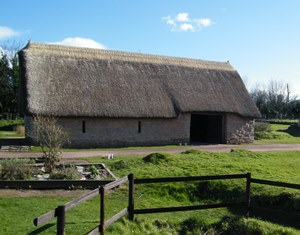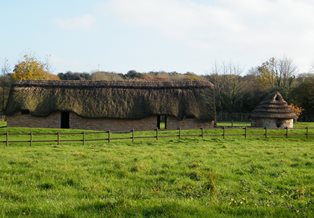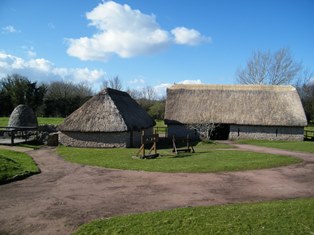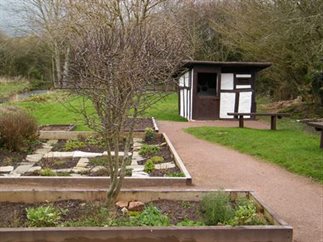The Village Buildings
Discover more about Cosmeston Medieval Village's buildings and their history
Although there can often be no certainty as to the original identity of a specific building, archaeological, architectural and historical information are used to recreate the village structures as closely to the originals as possible.

The Reeve's Buildings
The farm of Walter the village reeve is a series of buildings rented from the lord of the manor a cottage, barn and byre all constructed around an open courtyard and with adjacent gardens.
Although it cannot be certain that this is the reeve's home, the property is of such a standard that a villager of high status would have lived there.
The main of the village reeve role would have been to ensure that the village agriculture was running smoothly and that the peasants were looking after their crops and not encroaching onto their neighbours' property.

Jake’s Cottage
This simple, rectangular style of building would have housed a less well-off peasant member of the community. There were two types, 'customary' tenants or 'free' villagers, who were eligible to sit on a jury in the manor courts and fill official positions such as reeve or bailiff. The 'villein' tenants were 'unfree' villagers who were tied to the land and bound to the village. These tenants would have lived under many restrictions, unable to leave the manor or get married without the lord's permission and having their ability to look after their own crops severely curtailed by having to work on the lord of the manor's fields.
The Baker's House and Village Ovens
The village baker was a man of substance who rented a building in which he produced his good in ovens and sold his baked goods. Only the baker, having paid the lord of the manor rental for the ovens, was allowed to bake bread. This did not make him popular with the rest of the villagers. Next to the baker's cottage is a small building constructed around two ovens. One is for baking bread and the other is a malting oven for roasting barley to make ale, as the bakers cottage is also the village tavern.
Divider Line

The Tithe Barn
The village tithe barn is where taxes were recorded and stored by the village priest before being moved on for sale or distribution to various clergy. Of all the medieval taxes, the tithe had an impact on most. Everything that was grown, produced or made was subject to a 10 per cent tax by the church.
The Swineherd Cottage
In a village environment, the swineherd could find themselves responsible for most of the village pigs as they foraged through the surrounding woodland. The nature of the swineherd's work is reflected inside his house, which is a combination of home, pig yard and butcher's. Outside is a small run and pigsty for when the pigs are brought in from the woods.

The Herbalists Hovel and Herb Garden
During the original excavations the archaeological team discovered the ‘shadow’ of a structure located near the North end of the village. This feature has always been known as building ‘J’ Nobody has ever known much about its use or reason for being. This has led to staff onsite deciding to construct a ‘wattle and daub’ structure to recreate a possible example of the building and its use.
Today it is open as the ‘herbalist hovel’ this is an area where a wise woman of apothecary may rest and store herbs as she works the herb gardens under the watchful eye of the village Reeve.
The reconstructed element of the medieval village represents only a small part of what would once have been the manor of Cosmeston. An important part of the project is understanding the context of the village in relation to the surrounding landscape. This would have consisted of farmsteads, wetland and coastal fishing sites, pastoral and arable farming, woodland and of course, the manor house with its associated farmland, gardens, orchards, fishponds and dovecote.
View a Medieval village map showing the location of all the buildings at Cosmeston Medieval Village.